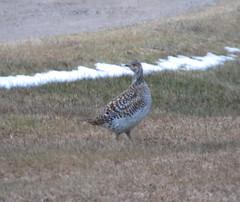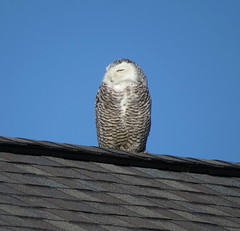It was a frigid 5 degrees under a brightening morning sky when I backed the bird-mobile out of the garage, pointing it north on highway 22/3, and drove towards Caesar Creek State Park. Within 2 minutes I had my first new bird for my January 100 list, a Pileated Woodpecker hammering away on a short tree by the side of the road. I’m hoping this is a good omen.
There’s loads of common birds I still need to check off at Caesars Creek and nearby Spring Valley Wildlife Area. Normally my first stop would be at the Harveysburg Road overlook, but today I made towards the beach in hope of finding the gull flock still on the beach before they disperse to feed. I found the flock without any problems and right in the middle was my Herring Gull. I continued to scan the area for Killdeer and Pipits without any luck.
I drove to various points around the lake scanning for any signs of waterfowl, and if it wasn’t for 2 Pied-billed Grebes the duck decoys left by hunters which was the most numerous thing on the lake. I packed it i and headed over to the visitors center to warm up and check the feeders.
The feeders at the visitors center usually draw your normal birds like Junco’s, Cardinals, Titmouse, and Chickadees. In the winter though for the past several years I’ve had very good luck in spotting Purple Finches at this location. During the Spring and Summer of last year the visitors center went through a large expansion so now they have 2 areas set up with feeders that you can watch from inside.
The visitor center expansion consisted of a long corridor with several offices connecting the original visitor center building to a large conference room. One of these offices along the corridor was open to the back of the building and the feeder area. Taking off my coat and hat I settled into a chair and held vigil.
After about 5 minutes a stunning male flew in.
 I apologize for the poor quality, since I was shooting through a window and the sun was at a low angle.
I apologize for the poor quality, since I was shooting through a window and the sun was at a low angle.
I love how Peterson describes them in his field guide, “a finch dipped in raspberry sauce”. Despite some peoples confusion between this species and the more common House Finch, once you see a Purple Finch next to a House Finch the difference becomes quite obvious.
The rest of the morning and early afternoon was spent checking out Spring Valley and a few gravel pits. It was during my drive to Spring Valley when I FINALLY spotted 3 large black birds soaring. Pulling off the highway and getting my bins out I saw that they were Black Vultures. All I need now are Turkey Vultures.
My grumbling stomach told me it was time to leave. Driving slowly I noticed a really small bird flitting about low in the branches of a tree by the side of the road. Stopping I got my bins on it to find a Golden-crowned Kinglet. Pulling to the side of the road I grabbed my camera in what I thought would be a futile attempt to get a picture of these ever moving birds.
Luck was on my side today.
New January birds were:
70: Purple Finch
71: Herring Gull
72: Pileated Woodpecker
73: Black Vulture
74: Golden-crowned Kinglet
75: Brown-headed Cowbird
76: Hermit Thrush
77: Cooper’s Hawk















































